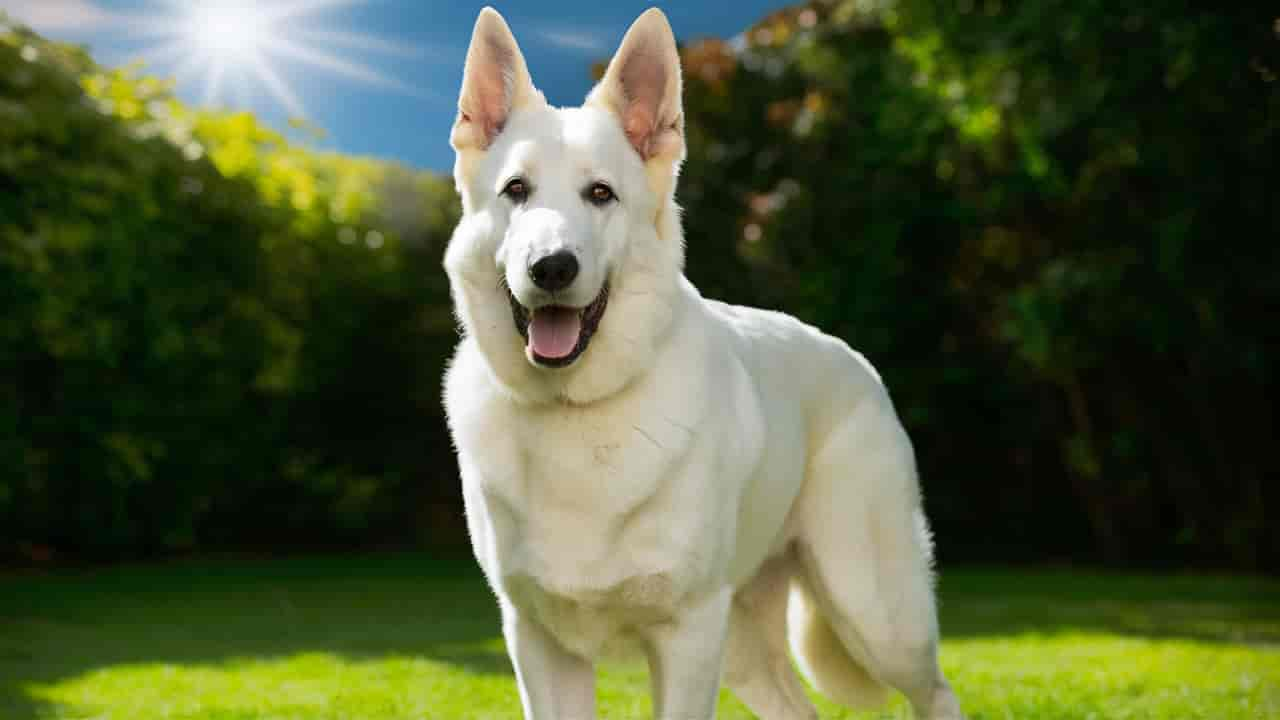White German Shepherd
Introduction
The White German Shepherd is a strikingly beautiful and unique variation of the traditional German Shepherd breed. With its pure white coat and noble bearing, this breed stands out not only for its looks but also for its remarkable qualities as a companion and working dog. Understanding the White German Shepherd, from its history and physical characteristics to its care and training needs, is crucial for anyone considering adding this magnificent dog to their family.
History and Origin
The history of the White German Shepherd is deeply intertwined with that of the standard German Shepherd. The breed was developed in the late 19th and early 20th centuries by Captain Max von Stephanitz in Germany, who aimed to create an ideal working dog. The white coat color in German Shepherds is due to a recessive gene, meaning that both parents must carry the gene for a puppy to be born white.
Initially, white-coated German Shepherds were not favored and were even excluded from some breed standards. However, enthusiasts recognized the beauty and capabilities of these dogs, leading to the establishment of dedicated breeding programs. Today, White German Shepherds are recognized by various kennel clubs and have a devoted following.
Physical Characteristics
White German Shepherds are known for their athletic build and elegant appearance. They typically stand between 22 to 26 inches tall at the shoulder and weigh between 50 to 90 pounds. Their coats are dense and can range from short to long, always exhibiting the striking white color that sets them apart. Despite their unique coloration, White German Shepherds share the same physical traits as their standard-colored counterparts, including a strong, muscular body, erect ears, and intelligent, expressive eyes.

Size and Weight
White German Shepherds are medium to large-sized dogs.Typically, females weigh between 50 and 70 pounds, while males typically weigh between 65 and 90 pounds. Their height ranges from 22 to 26 inches, with males being at the taller end of the spectrum.
Coat and Color
The most distinguishing feature of the White German Shepherd is its pure white coat. This coat can be either short or long and is typically double-layered, providing good protection against the elements. The undercoat is dense and soft, while the outer coat is straight and slightly harsh to the touch.
Unique Physical Traits
Apart from their coat color, White German Shepherds possess the same physical characteristics as standard German Shepherds. They have a well-proportioned, muscular body, a long bushy tail, and a distinctive head with a strong jaw and pointed ears. Their eyes are almond-shaped and usually dark brown, exuding intelligence and alertness.
Temperament and Personality
White German Shepherds are renowned for having a great temperament and an adaptable nature.They are loyal, intelligent, and protective, making them exceptional companions and watchdogs. These dogs are typically gentle and affectionate with their families, forming strong bonds and showing great patience with children.
General Behavior
White German Shepherds are confident and courageous dogs. They are highly trainable and eager to please, which makes them suitable for various roles, including service and therapy dogs. They are also very alert and observant, always ready to protect their loved ones if necessary.
Interaction with Families and Children
White German Shepherds are excellent family pets. They are renowned for being kind and understanding, particularly toward kids. These dogs often take on a protective role within the family, watching over their human companions with vigilance. Their playful yet gentle demeanor makes them great playmates for kids.
Social Behavior with Other Pets
When properly socialized from a young age, White German Shepherds can get along well with other pets. They may exhibit a natural herding instinct, which can sometimes lead to them trying to herd other animals. However, with proper training and socialization, they can live harmoniously with other dogs and even cats.
Training and Obedience
Training a White German Shepherd requires consistency, patience, and a positive approach. These dogs are highly intelligent and respond well to training, but they also have a strong will and need a firm yet gentle hand.
Training Techniques
Using positive reinforcement techniques, such as treats, praise, and play, is the most effective way to train a White German Shepherd. These dogs thrive on rewards and encouragement, and harsh methods can lead to fear and anxiety.
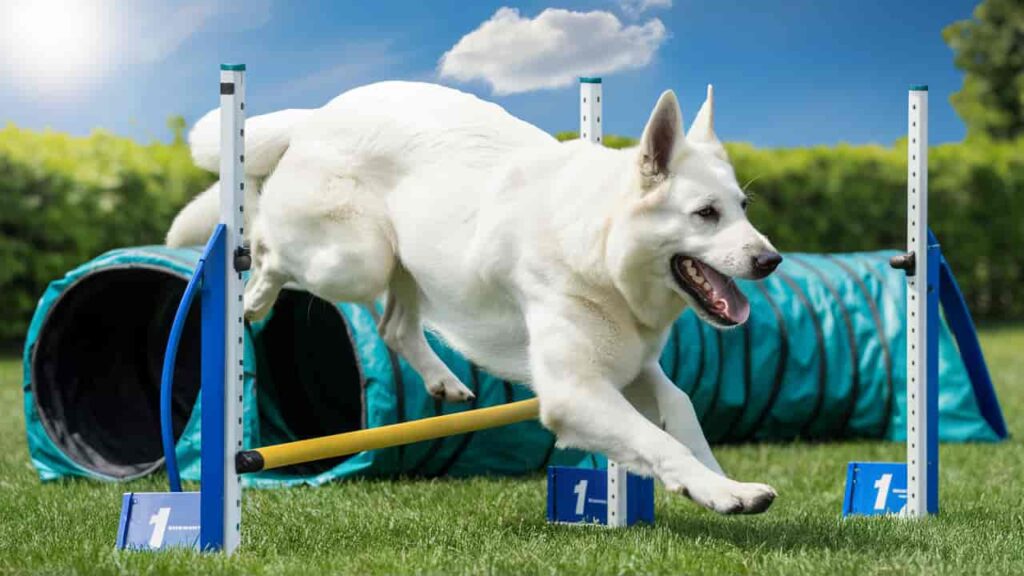
Importance of Early Training
Early training is crucial for White German Shepherds. Puppies are like sponges, absorbing everything around them, so it’s important to start training as soon as possible. Basic commands, house training, and socialization should be the focus in the early stages.
Advanced Training Tips
Once the basics are mastered, White German Shepherds can excel in advanced training. They are particularly good at obedience, agility, and herding competitions. Providing them with challenging tasks and advanced training helps keep their minds sharp and engaged.
Exercise and Activity Needs
White German Shepherds are active and energetic dogs that require regular exercise to stay healthy and happy. They enjoy a variety of activities and thrive in environments where they can use their physical and mental abilities.
Daily Exercise Requirements
These dogs need at least 60 to 90 minutes of exercise each day. This can involve playing, running, walks, and workouts. Providing sufficient exercise helps prevent boredom and associated behavioral issues.
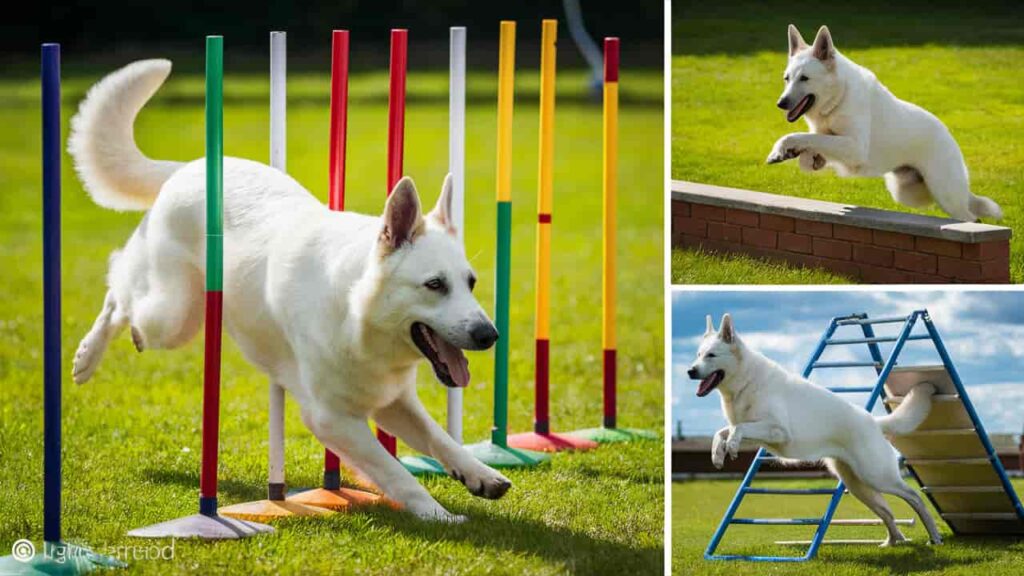
Types of Activities They Enjoy
White German Shepherds are active dogs that like swimming, jogging, hiking, and fetching among other things. They also excel in canine sports such as agility, obedience, and tracking. Engaging them in these activities keeps them fit and mentally stimulated.
Importance of Mental Stimulation
In addition to physical exercise, White German Shepherds need mental stimulation. Puzzle toys, interactive games, and training sessions that challenge their minds are excellent ways to keep them mentally sharp.Maintaining their interest is crucial since boredom can result in negative behaviors.
Health and Wellness
White German Shepherds are generally healthy dogs, but like all breeds, they are prone to certain health issues.Your dog’s lifespan can be extended and health can be maintained by being aware of these possible issues and taking preventative action.
Common Health Issues
Some common health issues in White German Shepherds include:
- Hip Dysplasia: A genetic condition where the hip joint doesn’t fit into the hip socket properly, leading to arthritis and pain.
- Elbow Dysplasia: This disorder affects the elbow joints and can result in lameness and discomfort, much like hip dysplasia.
- Degenerative Myelopathy:a degenerative spinal cord condition that impairs movement and coordination.
- Gastric Dilatation-Volvulus (Bloat): A serious condition where the stomach fills with gas and twists, requiring immediate veterinary attention.
- Allergies: White German Shepherds can be prone to skin allergies and sensitivities, often requiring special diets or treatments.
Preventative Care
Preventative care is crucial in maintaining the health of a White German Shepherd. Regular veterinary check-ups, vaccinations, and parasite prevention (fleas, ticks, and heartworms) are essential. Additionally, maintaining a healthy diet and weight can help prevent joint issues and other health problems.
Regular Vet Check-ups
Regular vet visits are important to monitor your dog’s health and catch any issues early. A physical examination, dental examination, and blood tests to look for any underlying diseases should all be part of an annual check-up. Elderly dogs might need to be visited more frequently.
Diet and Nutrition
A balanced diet is essential for the health and longevity of a White German Shepherd. High-quality commercial dog food that meets their nutritional needs is recommended, but some owners prefer to prepare homemade meals or feed raw diets.
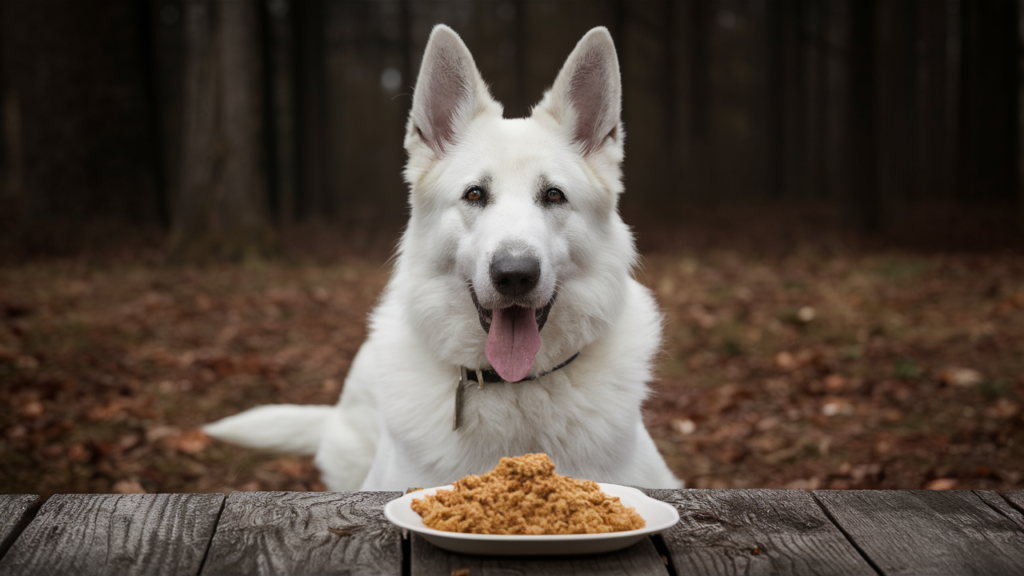
Ideal Diet for White German Shepherds
White German Shepherds benefit from a diet rich in protein, healthy fats, and essential vitamins and minerals. Look for dog foods that list meat as the first ingredient and avoid those with fillers like corn or soy. Fresh vegetables and fruits can also be included as treats or supplements.
Feeding Schedule
Most adult White German Shepherds do well with two meals a day. Puppies, however, should be fed more frequently, typically three to four times a day, to support their growth and development. Always ensure fresh water is available.
Supplements and Vitamins
Particularly for elderly dogs, supplements like glucosamine and chondroitin can promote joint health. The health of the skin and coat benefits from omega-3 fatty acids. Prior to introducing supplements to your dog’s diet, always get advice from your veterinarian.
Grooming and Maintenance
Proper grooming is important to keep your White German Shepherd healthy and looking their best. Their grooming needs can vary depending on their coat type (short or long).
Coat Care and Shedding
White German Shepherds shed year-round, with more intense shedding periods in the spring and fall. Regular brushing, at least a few times a week, helps manage shedding and keeps the coat healthy.Brushing every day could be required during times of high shedding.
Bathing and Hygiene
Bathing should be done as needed, typically every few months, or when your dog gets particularly dirty. For dogs, use a mild wash to prevent skin irritation.Over-bathing can strip the natural oils from their coat, leading to dryness.
Dental Care and Nail Trimming
Dental care is crucial for preventing periodontal disease.To help keep your dog’s teeth clean, give them dental chews or toys in addition to routine brushing. Regular nail trimming is necessary to avoid splitting and overgrowth. It’s time for a trim if you can hear your dog’s nails clicking on the floor.
Living Conditions
White German Shepherds are adaptable dogs that can thrive in various living conditions, provided their physical and mental needs are met.
Ideal Home Environment
These dogs do best in homes with ample space for them to move around. A fenced yard is ideal, allowing them to play and exercise freely. However, they can also adapt to apartment living if they receive sufficient daily exercise and mental stimulation.
Adapting to Different Climates
White German Shepherds can adapt to different climates but may need extra care in extreme weather conditions. In hot weather, ensure they have plenty of water and shade, and avoid vigorous exercise during peak heat. In cold weather, their double coat provides some insulation, but they may need additional warmth if temperatures drop significantly.
Suitable Living Space
While a large yard is ideal, White German Shepherds can also thrive in smaller spaces if they receive enough exercise. Regular walks, trips to the dog park, and engaging indoor activities can help keep them happy and healthy.
White German Shepherds and Families
White German Shepherds make excellent family pets due to their loyal, protective, and affectionate nature.
Compatibility with Children
These dogs have a reputation for being kind and patient with kids. They often form strong bonds with kids and are very protective of them. Supervision is always recommended with young children to ensure safe interactions.
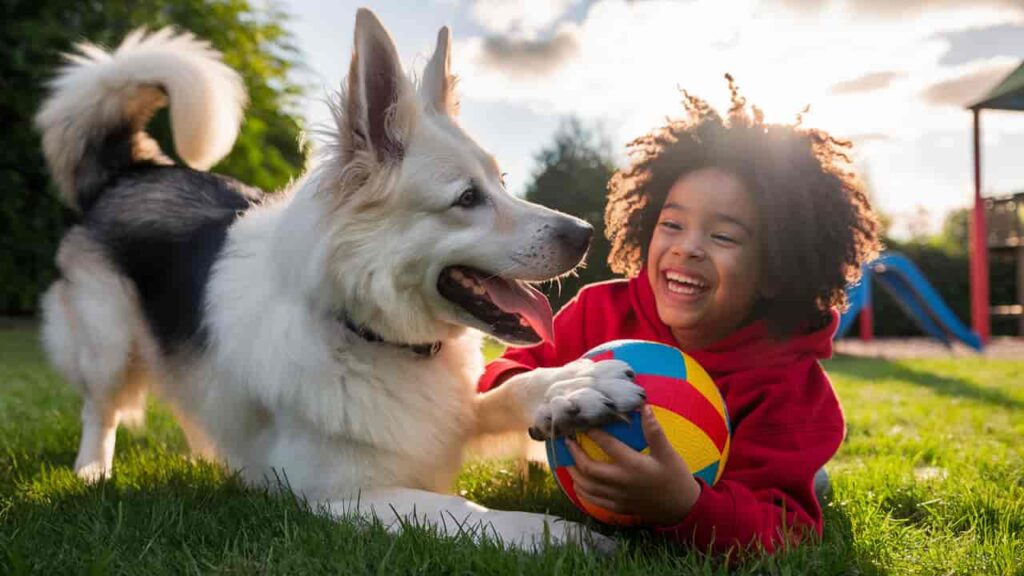
Role as a Family Protector
White German Shepherds have a natural protective instinct, making them excellent watchdogs. They are alert and quick to react to potential threats, but they are also discerning and usually friendly with guests once introduced.
Emotional Support and Companionship
Their intelligence and sensitivity make White German Shepherds wonderful emotional support animals. They are attuned to their owner’s emotions and can provide comfort and companionship during stressful times.
Socialization
Proper socialization is key to raising a well-adjusted White German Shepherd. Early and consistent socialization helps them develop into confident and well-behaved adults.
Importance of Socializing Puppies
Puppies are particularly receptive to new experiences. Early socialization, including exposure to different people, animals, and environments, helps prevent fear and aggression later in life.
Socialization Techniques
Positive reinforcement is crucial during socialization. Reward your dog with treats, praise, and play for calm and positive behavior in new situations. Enroll in puppy socialization classes to help them learn how to interact with other dogs and people.
Introducing to New Environments
Gradually introduce your White German Shepherd to new environments and experiences. Begin with low-stress scenarios and progressively escalate the intricacy.This lessens their nervousness and boosts their confidence.
Adoption and Buying Tips
Whether you choose to adopt or buy a White German Shepherd, it’s important to do thorough research and ensure you’re getting your dog from a reputable source.
Finding Reputable Breeders
Credible breeders place a high value on their dogs’ temperaments and general health. They will provide health clearances for the puppy’s parents and allow you to meet them. Avoid breeders who have multiple litters available at all times or who are reluctant to provide information about their breeding practices.
Adoption vs Buying
Adopting a White German Shepherd from a rescue organization or shelter can be a rewarding experience. A second shot at a loving home is what many amazing dogs are searching for. Adoption also helps combat the issues of overbreeding and pet homelessness.
Questions to Ask Breeders
When speaking with breeders, ask about the puppy’s health history, temperament, and socialization experiences. Inquire about any genetic testing done on the parents and request to see health clearances. A good breeder will be transparent and supportive throughout the process.
Myths and Misconceptions
Several myths and misconceptions surround White German Shepherds.It’s critical to distinguish reality from myth in order to choose the breed wisely.
Common Myths About the Breed
One common myth is that White German Shepherds are albino or suffer from genetic defects due to their white coat. In reality, their white coat is simply a color variation and does not indicate any inherent health problems. Another myth is that they are less capable working dogs compared to their standard-colored counterparts. However, White German Shepherds possess the same intelligence, strength, and versatility as any other German Shepherd.
Clarifying Misconceptions
White German Shepherds are not albino; they have normal pigmentation in their eyes and skin. Their white coat is due to a recessive gene and does not affect their overall health. Additionally, they are just as capable as other German Shepherds in roles such as service dogs, police dogs, and therapy dogs.
Educating Potential Owners
It’s important for potential owners to educate themselves about the breed.It is important to recognize the unique requirements and traits of White German Shepherds in order to provide them with the love and care they need. Encouraging proper training, socialization, and healthcare is part of responsible ownership.
Conclusion
Owning a White German Shepherd is a rewarding experience for those who appreciate their unique beauty, intelligence, and loyalty. These dogs make excellent companions and family members, offering both protection and affection. With proper training, socialization, and care, a White German Shepherd can thrive and bring immense joy to their owners.Their average lifespan is 9 nine to thirteen years.
FAQs
- Are White German Shepherds different from standard German Shepherds?
White German Shepherds are essentially the same as standard German Shepherds in terms of behavior, temperament, and physical traits, with the primary difference being their white coat color. - How much exercise does a White German Shepherd need?
They require at least 60 to 90 minutes of exercise daily, which can include walks, playtime, and mental stimulation activities. - Are White German Shepherds good with kids?
Yes, White German Shepherds are known for being gentle and protective with children, making them excellent family pets. - What are the grooming requirements for a White German Shepherd?
Regular brushing, occasional baths, dental care, and nail trimming are essential grooming practices to keep them healthy and clean. - How long do White German Shepherds typically live?
The average lifespan of a White German Shepherd is around 10 to 14 years, depending on their overall health and care.
